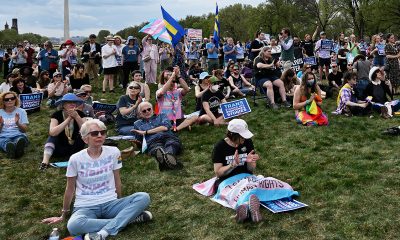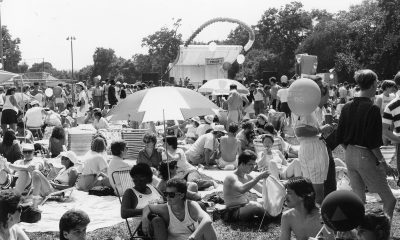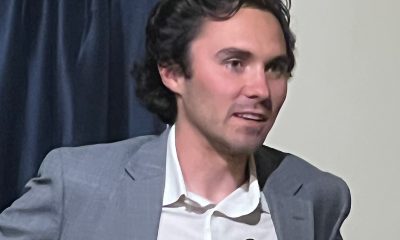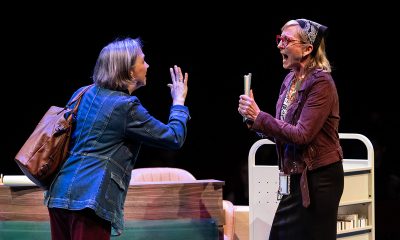Arts & Entertainment
Stonewall wasn’t the only LGBT riot
Lesser-known protests erupted in San Francisco

With the 50th anniversary of the June 1969 Stonewall riots in New York’s Greenwich Village taking place this weekend, the compelling story of how LGBT people fought back following the police raid on the Stonewall Inn gay bar will likely capture the attention this week of the LGBT community and its allies.
But those familiar with LGBT history point out that there were three other riots besides Stonewall in which LGBT people fought back against injustices by police, government officials, and society in general. All of them took place in San Francisco.
Compton’s Cafeteria Riot
One of them, known as the Compton’s Cafeteria Riot, took place in San Francisco’s Tenderloin neighborhood in August 1966, three years before Stonewall. Those familiar with it say it was led by LGBT people known then as drag queens and “cross dressers” but who today would be known to be transgender women.
Many of them hung out at the late night cafeteria, which operated as a restaurant.
According to an account by transgender historian Susan Stryker in her 2008 book “Transgender History,” the cafeteria’s trans customers and their gay male friends were frequently harassed by the cafeteria’s management and by police in the early and mid-1960s.
At the time, so-called “cross-dressing” was illegal in San Francisco, and police and local regulatory agencies often threatened to close bars or eateries like Compton’s for allowing such people to patronize their establishments.
Stryker reports in her book that the Compton’s Cafeteria riot was triggered when a police officer attempted to arrest a trans woman inside the cafeteria and she responded by throwing the coffee she was drinking in the officer’s face.
That act of defiance, coming on the heels of years of harassment by the police, prompted other trans people and their friends to “erupt,” Stryker wrote. People began to throw dishes and furniture and the cafeteria’s plate glass windows were smashed. When police reinforcements rushed to the scene the fighting spilled into the street, where people smashed the windows of a police car and set a sidewalk newsstand on fire.
Stryker, who also co-produced a documentary film on the riot called “Screaming Queens: The Riot at Compton’s Cafeteria,” reports that more than a dozen people were taken away by police in paddy wagons that night.
She reported that on the next night more transgender people, sex workers, Tenderloin neighborhood “street people,” and LGBT people in general returned to the scene to picket Compton’s Cafeteria after learning the management had banned transgender people from going back to the establishment.
In what observers consider an important pre-Stonewall development for LGBT rights, trans and LGBT youth under the guidance of the progressive Glide Memorial Church in San Francisco formed a group that staged protests over the next year or two against police harassment of trans and gay youth in the Tenderloin area.
White Night Riots
What has become known as the White Night Riots erupted in San Francisco on May 21, 1979 hours after news broke that a jury had rejected prosecutors’ call for a first-degree murder conviction for the man who assassinated gay rights icon and San Francisco Supervisor Harvey Milk and the city’s pro-LGBT mayor George Moscone.
To the shock and horror of San Francisco’s large LGBT community and its allies, the jury instead convicted ex-police officer and former supervisor Dan White of voluntary manslaughter for the two killings, prompting a judge to sentence him to seven years and eight months in prison. With good behavior, he would be eligible for release after serving just five years.
Legal observers said the jury appeared to have been persuaded by the defense attorneys’ argument that White suffered from an impaired mental state due to depression and the excessive consumption of fast food, which later became known as the “Twinkie defense.”
Police and prosecutors said White shot Milk and Moscone on Nov. 27, 1978 multiple times in the head and body execution style with a handgun inside their offices at City Hall, which White entered through an unguarded door he knew about as a former supervisor.
According to accounts by the media and by longtime LGBT and AIDS activist Cleve Jones, who worked on Milk’s staff and who was present during the riots, the LGBT community responded to the news about White’s verdict by organizing a peaceful protest in the city’s largely gay Castro neighborhood.
What started with about 500 people quickly grew to 1,500 as the protesters marched through the streets and swelled to more than 5,000 as the crowed reached City Hall in what observers described as an angry mood that took on the air of a mob.
Media accounts say some in the crowd began to smash the windows and glass front doors of the City Hall building as several of Milk’s friends and longtime supporters attempted to hold the crowd back. Although police officials said later that the large number of police officers dispatched to the scene were directed to hold back the crowd, many officers waded into the crowd and attacked the protesters with nightsticks, inflaming what was already a volatile situation.
The police action prompted angry protesters to begin smashing the windows of police cars and setting them and other cars on fire by tossing lit matchbooks into the cars, causing the gas tanks to explode. At least a dozen police cars and eight other cars were destroyed that way before the rioting ended later in the evening.
Media reports said at least 61 police officers and an estimated 100 or more protesters or members of the public were hospitalized as a result of the rioting. Additional people were injured, media reports said, when a group of police officers disobeyed orders from the chief of police not to retaliate and raided a gay bar in the Castro neighborhood later in the evening.
Witnesses said the renegade officers, who placed tape over their nametags and badges, smashed the Elephant Walk bar’s windows and attacked its patrons for about 15 minutes. They then went out on the street and attacked others they believed to be gays who participated in the rioting.
Further LGBT organized protests took place in the following days that did not trigger violence. One of the later protests drew more than 20,000 people who assembled peacefully at Castro and Market Streets. The city’s then mayor, Dianne Feinstein, and gay Supervisor Harry Britt, who replaced Milk on the Board of Supervisors, vowed to take steps to protect the rights of LGBT people and curtail anti-LGBT violence.
AB 101 Veto Riot
The last of the three known other LGBT riots took place in San Francisco on Sept. 30, 1991. Similar to the White Night Riots, it was triggered by breaking news earlier that day.
Then-California Gov. Pete Wilson (R) vetoed a major gay rights bill approved by the state legislature known as Assembly Bill 101, which called for banning employment discrimination based on someone’s sexual orientation. Wilson initially suggested he would sign the legislation, but political observers said he changed his mind at the behest of his party’s religious right faction and other conservatives whose support he needed for his re-election bid.
Several thousand outraged LGBT activists and their supporters marched from the Castro district to a downtown state office building to protest Wilson’s veto. The crowd far outnumbered startled police officers, who were not expecting such a large turnout. According to media reports, a small number of protesters smashed the building’s first floor windows and door, entered the building and started a fire that was quickly extinguished by firefighters but which resulted in more than $150,000 in damages.
That same week about 2,000 angry LGBT protesters in Los Angeles marched from West Hollywood to the Los Angeles Museum of Art, where Wilson was attending an opening of an exhibition of Mexican art, according to the L.A. Times. The protesters stopped short of rioting but set a California state flag on fire and burned Wilson in effigy, the Times reported.
Theater
‘Bad Books’ a timely look at censorship in local library
Influencer vs. conservative parent in Round House production

‘Bad Books’
Through May 4
Round House Theatre
4545 East-West Highway
Bethesda, Md.
Tickets start at $43
Roundhousetheatre.org
While a library might seem an unlikely place for a heated contretemps, it’s exactly the spot where adults go when they’re itching to battle out what books minors might be allowed to read.
In Sharyn Rothstein’s “Bad Books,” two women, The Mother (out actor Holly Twyford) and The Librarian (Kate Eastwood Norris), swiftly become mired in a quarrel that comes with some weighty repercussions.
The Mother is a popular conservative influencer on a mission. She’s furious that the local library has overstepped its bounds and she blames The Librarian, a woman who adheres to the “it takes a village” method of child rearing and is dedicated to the young people who approach her reference desk.
There’s some background. It seems The Librarian who dresses young (tight jackets and Doc Martens) and curses a blue streak, forged a friendship with Jeremy, a teenage library regular.
While the details are a bit hazy, it seems the troubled Jeremy confided in The Librarian regarding some personal issues. In return, she suggested a helpful book – Boob Juice.
Unsurprisingly, based solely on its title, the book has thrown The Mother into a pique of outrage. After finding Boob Juice in her son’s bedroom, she made a beeline to the library; and not incidentally, The Mother hasn’t read the recommended work and has no plans to do so.
Set in a suburb with lax gun laws, the story explores facets of division and conciliation. The Mother insists she isn’t so much about banning books as she is keeping some books away from young people until they’ve obtained parental approval.
“Bad Books” is performed in the round. Built on a rotating stage, Meghan Raham’s set is simple, pleasingly serviceable, and easily transforms from the library into a small corporate office, and later the assembly room of a church. Overhead floats a circular glass shelf filled with a cache of banned books. Things like a rolling book cart and a goldfish bowl add some flavor to the different locations.
The Mother wasn’t always a popular conservative warrior with an enthusiastic horde of followers.
Her past includes penning a book that later filled her with guilt and regret. She refers to that early questionable literary accomplishment as her bad book. And while over the years, she has persevered to find and destroy each and every printed copy, she hasn’t entirely succeeded.
Norris plays three women who figure meaningfully into the arc of Twyford’s mother character. In addition to The Librarian, Norris is The Manager, a broadly played piece of comic relief, and The Editor, a warm woman who reveals things about Jeremy that his own mother never knew.
Smartly staged by Ryan Rilette, the production is part of a National New Play Network Rolling World Premiere. While Rothstein’s script offers two strong roles (skillfully performed by celebrated actors Twyford and Norris), its ending feels too neatly resolved.
In the past, Twyford and Norris have successfully joined forces for numerous DMV productions including Studio Theatre’s production of David Auburn’s two-hander “Summer, 1976,” the story of a longtime and unlikely friendship between two women who meet as young mothers during the Bicentennial summer.
Though different, both The Librarian and The Mother share a strong and ultimately hopeful relationship with words.
There’s a quote from E.B. White’s classic “Charlotte’s Web” that pops up a couple of times in the briskly paced 80-minute play. Charlotte, the wise spider, says, “with just the right words you can change the world.”
Books
‘Pronoun Trouble’ reminds us that punctuation matters
‘They’ has been a shape-shifter for more than 700 years
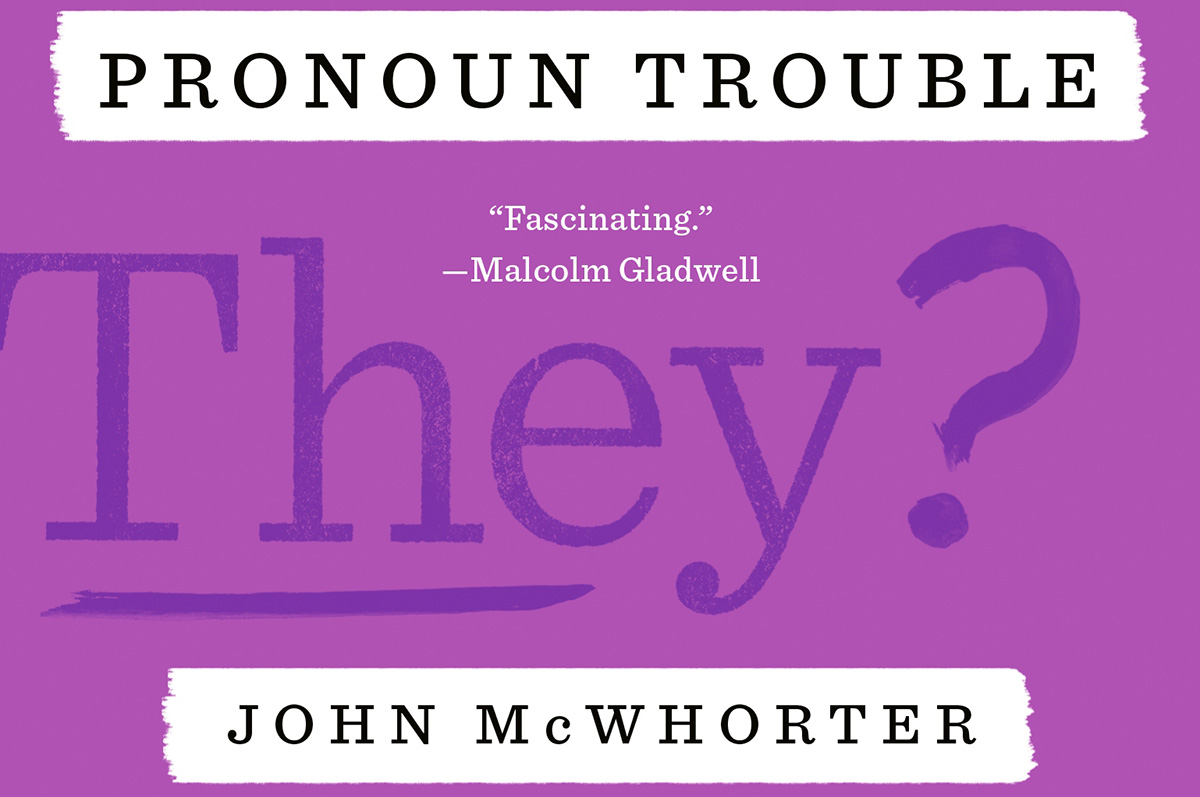
‘Pronoun Trouble’
By John McWhorter
c.2025, Avery
$28/240 pages
Punctuation matters.
It’s tempting to skip a period at the end of a sentence Tempting to overuse exclamation points!!! very tempting to MeSs with capital letters. Dont use apostrophes. Ask a question and ignore the proper punctuation commas or question marks because seriously who cares. So guess what? Someone does, punctuation really matters, and as you’ll see in “Pronoun Trouble” by John McWhorter, so do other parts of our language.

Conversation is an odd thing. It’s spontaneous, it ebbs and flows, and it’s often inferred. Take, for instance, if you talk about him. Chances are, everyone in the conversation knows who him is. Or he. That guy there.
That’s the handy part about pronouns. Says McWhorter, pronouns “function as shorthand” for whomever we’re discussing or referring to. They’re “part of our hardwiring,” they’re found in all languages, and they’ve been around for centuries.
And, yes, pronouns are fluid.
For example, there’s the first-person pronoun, I as in me and there we go again. The singular I solely affects what comes afterward. You say “he-she IS,” and “they-you ARE” but I am. From “Black English,” I has also morphed into the perfectly acceptable Ima, shorthand for “I am going to.” Mind blown.
If you love Shakespeare, you may’ve noticed that he uses both thou and you in his plays. The former was once left to commoners and lower classes, while the latter was for people of high status or less formal situations. From you, we get y’all, yeet, ya, you-uns, and yinz. We also get “you guys,” which may have nothing to do with guys.
We and us are warmer in tone because of the inclusion implied. She is often casually used to imply cars, boats, and – warmly or not – gay men, in certain settings. It “lacks personhood,” and to use it in reference to a human is “barbarity.”
And yes, though it can sometimes be confusing to modern speakers, the singular word “they” has been a “shape-shifter” for more than 700 years.
Your high school English teacher would be proud of you, if you pick up “Pronoun Trouble.” Sadly, though, you might need her again to make sense of big parts of this book: What you’ll find here is a delightful romp through language, but it’s also very erudite.
Author John McWhorter invites readers along to conjugate verbs, and doing so will take you back to ancient literature, on a fascinating journey that’s perfect for word nerds and anyone who loves language. You’ll likely find a bit of controversy here or there on various entries, but you’ll also find humor and pop culture, an explanation for why zie never took off, and assurance that the whole flap over strictly-gendered pronouns is nothing but overblown protestation. Readers who have opinions will like that.
Still, if you just want the pronoun you want, a little between-the-lines looking is necessary here, so beware. “Pronoun Trouble” is perfect for linguists, writers, and those who love to play with words but for most readers, it’s a different kind of book, period.
The Blade may receive commissions from qualifying purchases made via this post.
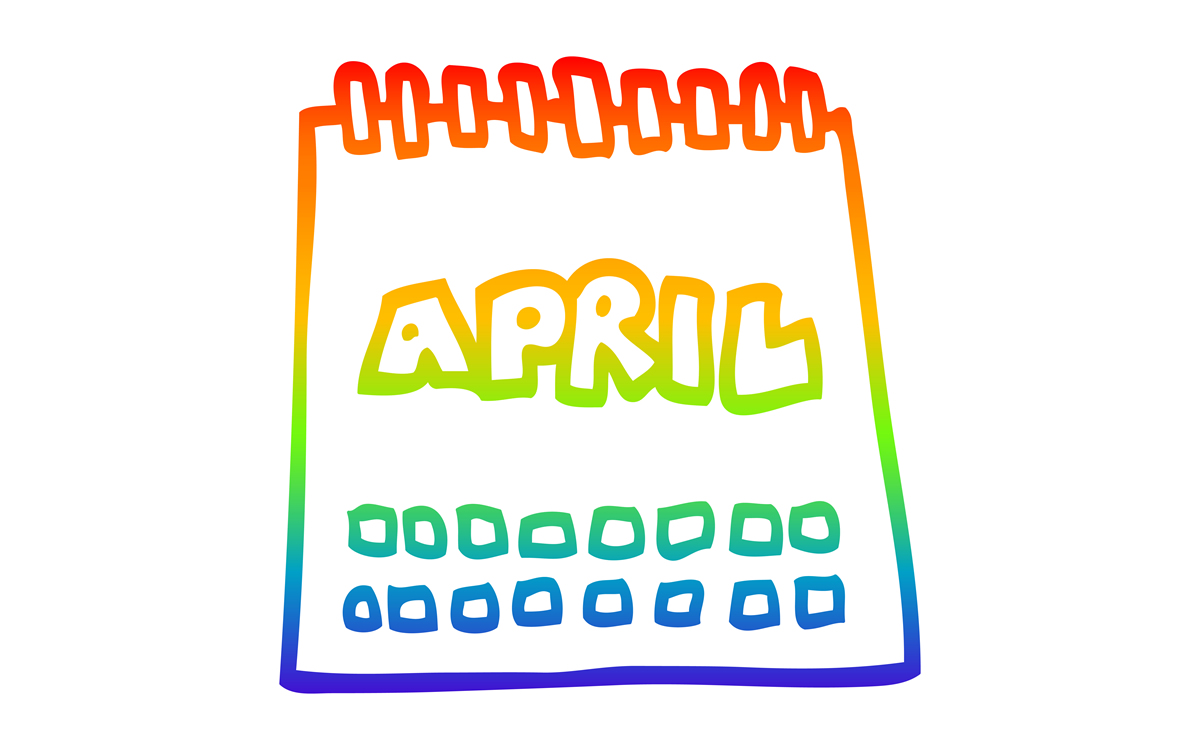
Friday, April 18
“Center Aging Friday Tea Time” will be at 2 p.m. on Zoom. This is a social hour for older LGBTQ+ adults. Guests are encouraged to bring a beverage of choice. For more details, email [email protected].
Go Gay DC will host “LGBTQ+ Community Social in the City” at 7 p.m. at Hotel Zena. This event is ideal for making new friends, professional networking, idea-sharing, and community building. This event is free and more details are available on Eventbrite.
Trans and Genderqueer Game Night will be at 6 p.m. at the DC Center for the LGBT Community. This will be a relaxing, laid-back evening of games and fun. All are welcome and there’ll be card and board games on hand. Feel free to bring your own games to share. For more details, visit the DC Center’s website.
Saturday, April 19
Go Gay DC will host “LGBTQ+ Community Brunch” at 11 a.m. at Freddie’s Beach Bar & Restaurant. This fun weekly event brings the DMV area LGBTQ+ community, including Allies, together for delicious food and conversation. Attendance is free and more details are available on Eventbrite.
LGBTQ People of Color Support Group will be at 7 p.m. on Zoom. This peer support group is an outlet for LGBTQ People of Color to come together and talk about anything affecting them in a space that strives to be safe and judgement free. There are all sorts of activities like watching movies, poetry events, storytelling, and just hanging out with others. For more information and events for LGBTQ People of Color, visit thedccenter.org/poc or facebook.com/centerpoc.
“Spark Sapphic Social” will be at 8 p.m. at Spark Social House. This weekly sapphic social is an opportunity to mix and mingle with other sapphics in D.C.’s newest LGBTQ bar. This event is free and more details are available on Eventbrite.
“DC Drag Brunch on Rooftop – Penthouse (Formerly at Lima Twist)” will be at 12 p.m. at Baby Shank Rooftop. Hosted by Miss Capital Pride, this is the ultimate drag brunch experience in Washington, D.C., featuring the fiercest queens around. Prepare to be entertained by glamorous drag queens and celebrated celebrity impersonators, including Taylor Swift, Lady Gaga, Beyoncé, Britney Spears, Nicki Minaj, Ariana Grande, Whitney Houston, Cher and many more. Tickets cost $27 and are available on Eventbrite.
Sunday, April 20
Queer Crayon Club will host “Queer Sketch Social” at 3 p.m. at Sinners and Saints. This is a fun event for LGBTQ+ adults to come together and color. Attendance is free and more details are available on Eventbrite.
Monday, April 21
“Center Aging Monday Coffee & Conversation” will be at 10 a.m. on Zoom. This is a social hour for older LGBTQ+ adults. Guests are encouraged to bring a beverage of choice. For more details, email [email protected].
Tuesday, April 22
Genderqueer DC will be at 7 p.m. on Zoom. This support group is for people who identify outside of the gender binary. Whether you’re bigender, agender, genderfluid, or just know that you’re not 100% cis – this is your group. For more details, visit www.genderqueerdc.org or Facebook.
Coming Out Discussion Group will be at 7 p.m. on Zoom. This is a peer-facilitated discussion group and a safe space to share experiences about coming out and discuss topics as it relates to doing so. For more details, visit the group’s Facebook.
Wednesday, April 23
Job Club will be at 6 p.m. on Zoom. This is a weekly job support program to help job entrants and seekers, including the long-term unemployed, improve self-confidence, motivation, resilience and productivity for effective job searches and networking — allowing participants to move away from being merely “applicants” toward being “candidates.” For more information, email [email protected] or visit thedccenter.org/careers.
Asexual and Aromantic Discussion Group will be at 7 p.m. on Zoom. This is a space where people who are questioning this aspect of their identity or those who identify as asexual and/or aromantic can come together, share stories and experiences, and discuss various topics. For more details, email [email protected].
Thursday, April 24
Virtual Yoga with Sarah M. will be at 7 p.m. on Zoom. This is a free weekly class focusing on yoga, breath work, and meditation. For more details, visit the DC Center for the LGBT Community’s website.
DC Anti-Violence Project Open Meeting will be at 7 p.m. on Zoom. This meeting is open to anyone interested in learning more and getting involved in lessening violence both within and directed towards the LGBT communities. For more information, visit Facebook or Twitter.

